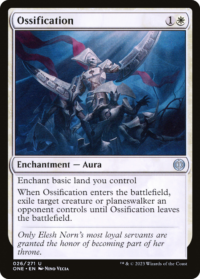Standard as a format was recently turned on its head yet again, with the unveiling of a plan to push back rotation and make Standard a three-year format instead of two year, where it’s been since rotation became a thing way back in the day. With this announcement came a series of bans, rocking the format by taking out a huge number of the best cards from the most popular decks. Since the ban announcement, we’ve seen players scramble back to old and unaffected favorites, or hunker down in the brew house to see what new deck could be had with the format’s remains. While many players are continuing to find success with Good Stuff Piles™ such as Esper Legends and Rakdos Midrange, others are testing the waters and seeing excellent placements in events by resubmitting decks that were previously pushed out of the top tiers by the Black Red Menace. Specifically with the omission of Invoke Despair, the format now has a bit of a gap in main-deck-playable enchantment hate. That’s where today’s deck comes in. Let’s take a dive into Selesnya Enchantments.


Budget Standard Selesnya Enchantments by Darren Magnotti
Creature (18)
Sorcery (4)
Instant (2)
Enchantment (16)
The Deck
Selesnya Enchantments is, as the name implies, an enchantment-based midrange deck that looks to take advantage of the many synergies rewarded from Kamigawa: Neon Dynasty to those willing to commit their entire deck to an enchantment theme. The deck tries to ride the line between aggressive beatdown deck and value-oriented control, and is capable of drawing nearly as many cards as it can deal damage over the course of a game. This is one of those decks that relies on inevitability to get over aggressive opponents, so drawing all of those cards just serves to get us to that crucial endgame point quickly and reliably.
Enchantments is one of those classic examples of “the midrange deck that beats other midrange decks.” In a world where white and black decks are the vast majority of your opponents, it just makes sense to try and play the versatile yet naturally resilient option that can keep pace with most of the answers available. Like similar decks before it, Enchantments can also generate such a wave of value that opposing midrange decks won’t be able to keep up even if their answers do line up well against what we’re up to. This puts Enchantments in a spot to pounce on the metagame, something that it’s started to do with regularity lately.
The Aggro Plan




The Value Plan




How Does It Play?
Selesnya Enchantments is, for all intents and purposes, a deck that does a very simple thing in a fairly complicated way. On the surface, none of the cards are very flashy or exciting, but working with the deck from the driver’s seat showcases a decision tree that’s a mile long and wide. Being a snowballing deck, it can build on all or any of its previous plays in such a way that it sort of doesn’t matter which route you take, but in the face of any disruption, the deck still has a non-zero amount of game and choices to make. With the end result typically being the same – swinging in with a huge Katilda or army of Spirits – you aren’t particularly punished for being interacted with, but the deck can definitely punish poor piloting. The trick is to foresee your board state a turn or two in advance, and try to figure out all of your different paths to take on a turn by turn basis to get there.
Against the metagame on the whole, the deck performs very well against both the midrange piles and the red decks that many players have been defaulting to. Enchantments can gain a ton of life between Naturalist and Katilda, so outpacing red isn’t a huge challenge, and beating on midrange decks is what this list has always been up to anyway. As the Standard landscape continues to shift, there may be some necessary alterations to the list and specifically to the sideboard, but in a land without meaningful enchantment interaction, a deck like this will never have trouble surviving or even thriving.
Upgrades

Standard Selesnya Enchantments by IslandGoSAMe
Creature (18)
Sorcery (4)
Instant (2)
Enchantment (16)
There isn’t a whole lot to do in terms of pumping additional value into this deck. Channel lands like Boseiju or even Eiganjo do provide some extra utility, though aren’t particularly necessary for the deck’s success. The number of cards that the deck sees over the course of a game means that additional dual lands aren’t required either, which is always a nice bonus. We were even able to keep in the Wedding Announcements, an essential piece to fight through those grindy and control matchups, so that isn’t even on our list of things to pick up. This is one of the more budget-friendly decks that’s been featured here, which is always a welcome surprise.
That’s all for this one. Enchantments is a fun deck, and I think that Standard is in a pretty good place moving forward into this next year. There are plenty of powerful cards that will make waves upon arrival, but getting the chance to really extract our value out of our cards for an entire extra year is a huge boon to budget players everywhere. Hopefully we’re also able to pick up the cards that our decks need to stay relevant, and that this new longer Standard doesn’t end up feeling like how Modern does to some players where their cards and decks become simply outclassed over time by power creep. I suppose we’ll find out when we find out. Until next time, stay safe, play smart and thanks for reading.
